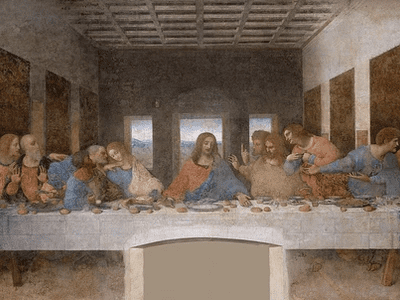High Renaissance Simplified
The phrase “High Renaissance” refers to an era of artistic creation that art historians consider to be the apex, or pinnacle, of the Renaissance period. High Renaissance painters include Leonardo da Vinci, Michelangelo, and Raphael, among others.
Summary of High Renaissance
The High Renaissance, later used to represent the Renaissance’s creative apex, refers to a thirty-year period highlighted by pioneering, iconic works of art created in Italy amid what was considered a prosperous socio-economic prime. A revival of classical art combined with a deep investigation into the humanities spawned artists of unparalleled mastery whose creations were informed by a keen understanding of science, anatomy, and architecture, and are still among the most awe-inspiring works of excellence in the historical art canon today.
Although many artists competed for status and commissions during the High Renaissance, Leonardo da Vinci, Michelangelo, Raphael, and architect Donato Bramante are unquestionably the period’s most famous legends, exemplifying the term “Renaissance” man in their mastery of multiple subjects and interests.
A cultural trend toward Humanism emerged at this time, pushing artists to revert to Classical Roman and Greek ideals about universal man and his position in the universe. This was a break from the idealised religious iconography of the mediaeval age, resulting in new representations of heavenly themes that were more resonant and human in feeling and expression.
A variety of methods acquired from Early Renaissance painters were used and refined by High Renaissance artists. The use of linear perspective to create extreme depth, highly accurate and scientifically correct depictions of human anatomy, the foreshortening of figures and subjects within elevated paintings and sculptures to provide an authentic viewing experience from below, and trompe l’oeil effects to seamlessly incorporate architectural elements into a work of art were among the techniques used.
There was a surge of new styles that were revolutionary at the time. Sfumato, a glazing effect that revolutionised the mixing of tone and colour, was invented by Leonardo, ceiling paintings, were formed, aiming to rapturously lure spectators’ attention up into a heavenly countenance.
The era is known for reintroducing aesthetic standards into art. In architecture and art, the High Renaissance painters’ main objectives were to portray pieces of aesthetic, symmetrical, and compositional excellence, whether depicting holy figures or common individuals.
Why is it Called High Renaissance?
High Renaissance art is referred to as “High” because it is seen to be the time when the Renaissance’s aesthetic ideals and ambitions were most fully realised. Michelangelo, Raphael, and Leonardo da Vinci are often regarded as the three most important figures in 16th-century High Renaissance art.
Key Art in High Renaissance
The Last Supper
By: Leonardo da Vinci
1490

This picture is one of the most well-known in the world. It portrays Christ as a triangle hub in the middle, flanked by his followers sat beside him during the Last Supper on the eve of his most famous betrayal by Judas Iscariot. The group is seated behind a large rectangular table that serves as a barrier between the observer and the participants in this holy time. The walls on each side generate diagonals that shrink toward three open windows in the distance behind Christ, emphasising his central significance in the setting and the dramatic consequences achieved via the use of linear perspective.
David
By: Michelangelo
1504

The hero David meets the monster Goliath in this renowned monument, which stands over 17 feet tall. His strong form simultaneously echoes and differs from traditional Greek sculpture, as his long arms and huge hands reflect the awkwardness of teenage development. Michelangelo deviated from earlier depictions by representing the time before the fight, rather than Goliath or the aftermath, when David turns to evaluate the threat, his big eyes and high forehead indicating anxiety. Only the slingshot draped over David’s shoulder identifies him as the Biblical hero, resulting in a startling simplicity.
Mona Lisa
By: Leonardo da Vinci
1503-1519

The most renowned of the paintings portrays a lady dressed in beautiful textiles in gentle fall colours, in three quarters perspective, with an enigmatic grin as she stares at the observer. She is framed by a spectacular scene of jagged mountain peaks, rock pinnacles, lakes dropping in steep winding river canyons, and serpentine roadways while she rests in a chair, resting her arms on an armrest seen in the darkened foreground. The woman seems self-assured, her demeanour evoking a sense of peaceful tranquilly.
School of Athens
By: Raphael
1511

The painting becomes a visual representation of the blossoming Renaissance embrace of humanism by mixing characters from the modern world with venerated ancient Greeks. Raphael ingeniously used colour to convey a feeling of rapid intellectual movement, as tones of blue on the right and red on the left lead the eye down the perspective’s diagonals toward Plato and Aristotle.
Information Citations
En.wikipedia.org, https://en.wikipedia.org/.
Recommend0 recommendationsPublished in Art History, Art Movements, Resources


Responses